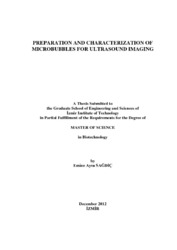Please use this identifier to cite or link to this item:
https://hdl.handle.net/11147/3540Full metadata record
| DC Field | Value | Language |
|---|---|---|
| dc.contributor.advisor | Kılıçç Özdemir, Sevgi | - |
| dc.contributor.author | Sağdıç, Emine Aysu | - |
| dc.date.accessioned | 2014-07-22T13:51:46Z | - |
| dc.date.available | 2014-07-22T13:51:46Z | - |
| dc.date.issued | 2012 | - |
| dc.identifier.uri | http://hdl.handle.net/11147/3540 | - |
| dc.description | Thesis (Master)--Izmir Institute of Technology, Biotechnology, Izmir, 2012 | en_US |
| dc.description | Includes bibliographical references (leaves: 91-100) | en_US |
| dc.description | Text in English; Abstract: Turkish and English | en_US |
| dc.description | xiii, 100 leaves | en_US |
| dc.description | Full text release delayed at author's request until 2016.01.09 | en_US |
| dc.description.abstract | Ultrasound is widely used in clinical settings for diagnosis of diseases. However, the image quality in some cases is not at desirable level because most of the tissues have similar acoustic properties to many tumors. Microbubbles administired to the systemic circulation during imaging are known to increase the quality, creating contrast with respect to the surrounding tissues. Unfortunately, current formulations of microbubbles composed of phospholipid (mainly PC) and emulsifier have been found to be unstable for ultrasound imaging. In this study, it was aimed to engineer the shell structure of microbubbles to develop more stable, targetable microbubbles and investigate their adhesion characteristics to breast cancer cells as a model system. Our results indicated that increasing content of PEG40 St in the formulation resulted in microbubbles with higher yield and stability, being optimum at 50 mole %. Incorporation of lipopolymers as emulsifier instead of PEG40St in the formulation influenced stability adversely. Addition of a phospholipid capable of secondary interactions to the formulation had improved stability and size of the microbbubles, depending on the content and type of head group of the phospholipid. Usage of less water-soluble gas in the core of new microbubbles did not have further effect on the stability, as observed with the microbubbles of the current formulation. This result may suggest that the new microbubbles’ shell is densely packed such that gas diffusion is enormously minimized/inhibited. Moreover, selected formulations developed in this study provided much more adhesion than the current formulation to the cell of interest. | en_US |
| dc.language.iso | en | en_US |
| dc.publisher | Izmir Institute of Technology | en_US |
| dc.rights | info:eu-repo/semantics/openAccess | en_US |
| dc.subject.lcsh | Microbubbles | en |
| dc.subject.lcsh | Nanobiotechnology | en |
| dc.subject.lcsh | Ultrasonic imaging | en |
| dc.title | Preparation and Characterization of Microbubbles for Ultrasoundimaging | en_US |
| dc.type | Master Thesis | en_US |
| dc.institutionauthor | Sağdıç, Emine Aysu | - |
| dc.department | Thesis (Master)--İzmir Institute of Technology, Bioengineering | en_US |
| dc.relation.publicationcategory | Tez | en_US |
| dc.identifier.wosquality | N/A | - |
| dc.identifier.scopusquality | N/A | - |
| item.openairecristype | http://purl.org/coar/resource_type/c_18cf | - |
| item.languageiso639-1 | en | - |
| item.openairetype | Master Thesis | - |
| item.grantfulltext | open | - |
| item.fulltext | With Fulltext | - |
| item.cerifentitytype | Publications | - |
| Appears in Collections: | Master Degree / Yüksek Lisans Tezleri | |
Files in This Item:
| File | Description | Size | Format | |
|---|---|---|---|---|
| 453871.pdf | MasterThesis | 3.04 MB | Adobe PDF |  View/Open |
CORE Recommender
Page view(s)
194
checked on Mar 31, 2025
Download(s)
108
checked on Mar 31, 2025
Google ScholarTM
Check
Items in GCRIS Repository are protected by copyright, with all rights reserved, unless otherwise indicated.